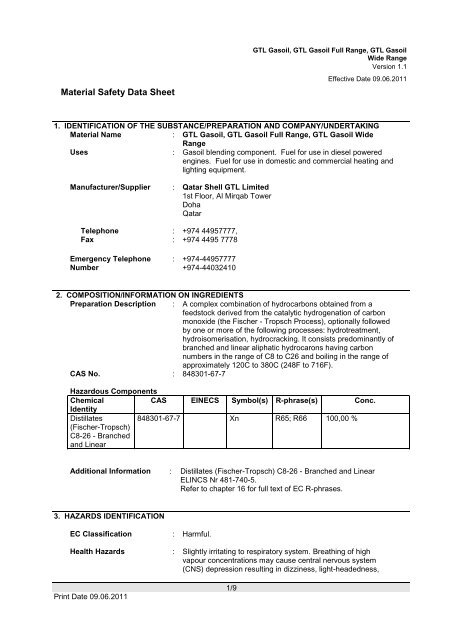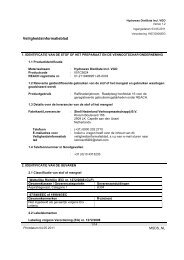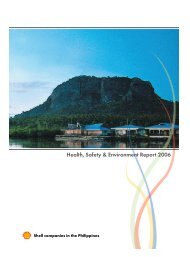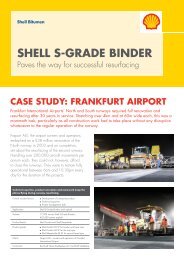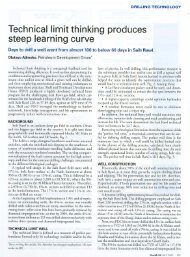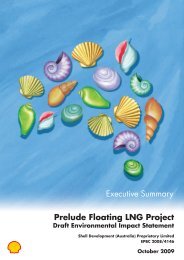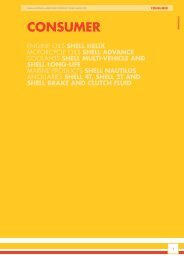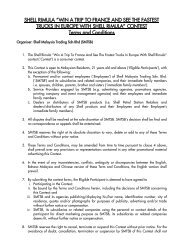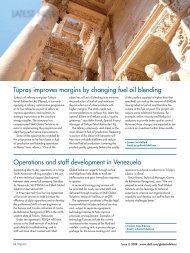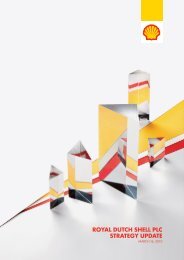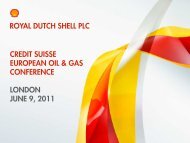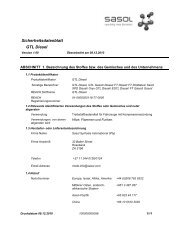Material Safety Data Sheet - Shell
Material Safety Data Sheet - Shell
Material Safety Data Sheet - Shell
You also want an ePaper? Increase the reach of your titles
YUMPU automatically turns print PDFs into web optimized ePapers that Google loves.
<strong>Material</strong> <strong>Safety</strong> <strong>Data</strong> <strong>Sheet</strong><br />
Print Date 09.06.2011<br />
1/9<br />
GTL Gasoil, GTL Gasoil Full Range, GTL Gasoil<br />
Wide Range<br />
Version 1.1<br />
Effective Date 09.06.2011<br />
1. IDENTIFICATION OF THE SUBSTANCE/PREPARATION AND COMPANY/UNDERTAKING<br />
<strong>Material</strong> Name : GTL Gasoil, GTL Gasoil Full Range, GTL Gasoil Wide<br />
Uses<br />
Range<br />
Manufacturer/Supplier : Qatar <strong>Shell</strong> GTL Limited<br />
1st Floor, Al Mirqab Tower<br />
Doha<br />
Qatar<br />
Telephone : +974 44957777,<br />
Fax : +974 4495 7778<br />
Emergency Telephone<br />
Number<br />
: Gasoil blending component. Fuel for use in diesel powered<br />
engines. Fuel for use in domestic and commercial heating and<br />
lighting equipment.<br />
: +974-44957777<br />
+974-44032410<br />
2. COMPOSITION/INFORMATION ON INGREDIENTS<br />
Preparation Description : A complex combination of hydrocarbons obtained from a<br />
feedstock derived from the catalytic hydrogenation of carbon<br />
monoxide (the Fischer - Tropsch Process), optionally followed<br />
by one or more of the following processes: hydrotreatment,<br />
hydroisomerisation, hydrocracking. It consists predominantly of<br />
branched and linear aliphatic hydrocarons having carbon<br />
numbers in the range of C8 to C26 and boiling in the range of<br />
approximately 120C to 380C (248F to 716F).<br />
CAS No. : 848301-67-7<br />
Hazardous Components<br />
Chemical<br />
Identity<br />
CAS EINECS Symbol(s) R-phrase(s) Conc.<br />
Distillates<br />
(Fischer-Tropsch)<br />
C8-26 - Branched<br />
and Linear<br />
848301-67-7 Xn R65; R66 100,00 %<br />
Additional Information : Distillates (Fischer-Tropsch) C8-26 - Branched and Linear<br />
ELINCS Nr 481-740-5.<br />
Refer to chapter 16 for full text of EC R-phrases.<br />
3. HAZARDS IDENTIFICATION<br />
EC Classification : Harmful.<br />
Health Hazards<br />
: Slightly irritating to respiratory system. Breathing of high<br />
vapour concentrations may cause central nervous system<br />
(CNS) depression resulting in dizziness, light-headedness,
<strong>Material</strong> <strong>Safety</strong> <strong>Data</strong> <strong>Sheet</strong><br />
Print Date 09.06.2011<br />
2/9<br />
GTL Gasoil, GTL Gasoil Full Range, GTL Gasoil<br />
Wide Range<br />
Version 1.1<br />
Effective Date 09.06.2011<br />
headache and nausea. May cause moderate irritation to skin.<br />
Repeated exposure may cause skin dryness or cracking.<br />
Harmful: may cause lung damage if swallowed.<br />
Signs and Symptoms : If material enters lungs, signs and symptoms may include<br />
coughing, choking, wheezing, difficulty in breathing, chest<br />
congestion, shortness of breath, and/or fever. The onset of<br />
respiratory symptoms may be delayed for several hours after<br />
exposure.<br />
Defatting dermatitis signs and symptoms may include a<br />
burning sensation and/or a dried/cracked appearance.<br />
<strong>Safety</strong> Hazards : May ignite on surfaces at temperatures above auto-ignition<br />
temperature. Vapour in the headspace of tanks and containers<br />
may ignite and explode at temperatures exceeding autoignition<br />
temperature, where vapour concentrations are within<br />
the flammability range. Electrostatic charges may be generated<br />
during pumping. Electrostatic discharge may cause fire.<br />
Additional Information : This product is intended for use in closed systems only.<br />
4. FIRST AID MEASURES<br />
Inhalation : Remove to fresh air. If rapid recovery does not occur, transport<br />
to nearest medical facility for additional treatment.<br />
Skin Contact : Remove contaminated clothing. Immediately flush skin with<br />
large amounts of water for at least 15 minutes, and follow by<br />
washing with soap and water if available. If redness, swelling,<br />
pain and/or blisters occur, transport to the nearest medical<br />
facility for additional treatment.<br />
Eye Contact : Flush eye with copious quantities of water. If persistent<br />
irritation occurs, obtain medical attention.<br />
Ingestion : If swallowed, do not induce vomiting: transport to nearest<br />
medical facility for additional treatment. If vomiting occurs<br />
spontaneously, keep head below hips to prevent aspiration. If<br />
any of the following delayed signs and symptoms appear within<br />
the next 6 hours, transport to the nearest medical facility: fever<br />
greater than 101° F (38.3°C), shortness of breath, chest<br />
congestion or continued coughing or wheezing.<br />
Advice to Physician : Treat symptomatically.<br />
5. FIRE FIGHTING MEASURES<br />
Clear fire area of all non-emergency personnel.<br />
Specific Hazards : Hazardous combustion products may include: A complex<br />
mixture of airborne solid and liquid particulates and gases<br />
(smoke). Carbon monoxide. Unidentified organic and inorganic<br />
compounds. Carbon monoxide may be evolved if incomplete<br />
combustion occurs. Will float and can be reignited on surface<br />
water. Flammable vapours may be present even at<br />
temperatures below the flash point.<br />
Suitable Extinguishing : Foam, water spray or fog. Dry chemical powder, carbon<br />
Media<br />
dioxide, sand or earth may be used for small fires only.<br />
Unsuitable Extinguishing : Do not use water in a jet.<br />
Media<br />
Protective Equipment for<br />
Firefighters<br />
: Wear full protective clothing and self-contained breathing<br />
apparatus.
<strong>Material</strong> <strong>Safety</strong> <strong>Data</strong> <strong>Sheet</strong><br />
GTL Gasoil, GTL Gasoil Full Range, GTL Gasoil<br />
Wide Range<br />
Version 1.1<br />
Additional Advice : Keep adjacent containers cool by spraying with water.<br />
Print Date 09.06.2011<br />
3/9<br />
Effective Date 09.06.2011<br />
6. ACCIDENTAL RELEASE MEASURES<br />
Avoid contact with spilled or released material. For guidance on selection of personal protective<br />
equipment see Chapter 8 of this <strong>Material</strong> <strong>Safety</strong> <strong>Data</strong> <strong>Sheet</strong>. See Chapter 13 for information on<br />
disposal. Observe the relevant local and international regulations. Evacuate the area of all nonessential<br />
personnel. Ventilate contaminated area thoroughly.<br />
Protective measures : Do not breathe fumes, vapour. Do not operate electrical<br />
equipment. Shut off leaks, if possible without personal risks.<br />
Remove all possible sources of ignition in the surrounding<br />
area. Use appropriate containment (of product and fire fighting<br />
water) to avoid environmental contamination. Prevent from<br />
spreading or entering drains, ditches or rivers by using sand,<br />
earth, or other appropriate barriers. Attempt to disperse the<br />
vapour or to direct its flow to a safe location for example by<br />
using fog sprays. Take precautionary measures against static<br />
discharge. Ensure electrical continuity by bonding and<br />
grounding (earthing) all equipment.<br />
Clean Up Methods : For small liquid spills (< 1 drum), transfer by mechanical means<br />
to a labelled, sealable container for product recovery or safe<br />
disposal. Allow residues to evaporate or soak up with an<br />
appropriate absorbent material and dispose of safely. Remove<br />
contaminated soil and dispose of safely.<br />
For large liquid spills (> 1 drum), transfer by mechanical means<br />
such as vacuum truck to a salvage tank for recovery or safe<br />
disposal. Do not flush away residues with water. Retain as<br />
contaminated waste. Allow residues to evaporate or soak up<br />
with an appropriate absorbent material and dispose of safely.<br />
Remove contaminated soil and dispose of safely. Shovel into a<br />
suitable clearly marked container for disposal or reclamation in<br />
accordance with local regulations.<br />
Additional Advice : Notify authorities if any exposure to the general public or the<br />
environment occurs or is likely to occur. Local authorities<br />
should be advised if significant spillages cannot be contained.<br />
Maritime spillages should be dealt with using a Shipboard Oil<br />
Pollution Emergency Plan (SOPEP), as required by MARPOL<br />
Annex 1 Regulation 26.<br />
7. HANDLING AND STORAGE<br />
General Precautions<br />
: Avoid breathing vapours or contact with material. Only use in<br />
well ventilated areas. Wash thoroughly after handling. For<br />
guidance on selection of personal protective equipment see<br />
Chapter 8 of this <strong>Material</strong> <strong>Safety</strong> <strong>Data</strong> <strong>Sheet</strong>. Use the<br />
information in this data sheet as input to a risk assessment of<br />
local circumstances to help determine appropriate controls for<br />
safe handling, storage and disposal of this material. Air-dry<br />
contaminated clothing in a well-ventilated area before<br />
laundering. Properly dispose of any contaminated rags or<br />
cleaning materials in order to prevent fires. Prevent spillages.<br />
Use local exhaust ventilation if there is risk of inhalation of<br />
vapours, mists or aerosols. Never siphon by mouth.
<strong>Material</strong> <strong>Safety</strong> <strong>Data</strong> <strong>Sheet</strong><br />
Print Date 09.06.2011<br />
4/9<br />
GTL Gasoil, GTL Gasoil Full Range, GTL Gasoil<br />
Wide Range<br />
Version 1.1<br />
Effective Date 09.06.2011<br />
Contaminated leather articles including shoes cannot be<br />
decontaminated and should be destroyed to prevent reuse. For<br />
comprehensive advice on handling, product transfer, storage<br />
and tank cleaning refer to the product supplier.<br />
Maintenance and Fuelling Activities - Avoid inhalation of<br />
vapours and contact with skin.<br />
Handling : Avoid inhaling vapour and/or mists. Avoid prolonged or<br />
repeated contact with skin. When using do not eat or drink.<br />
Extinguish any naked flames. Do not smoke. Remove ignition<br />
sources. Avoid sparks. Earth all equipment. Electrostatic<br />
charges may be generated during pumping. Electrostatic<br />
discharge may cause fire. Not expected to be a health hazard<br />
when used under normal conditions. The vapour is heavier<br />
than air, spreads along the ground and distant ignition is<br />
possible.<br />
Storage : Drum and small container storage: Drums should be stacked to<br />
a maximum of 3 high. Use properly labelled and closeable<br />
containers. Tank storage: Tanks must be specifically designed<br />
for use with this product. Bulk storage tanks should be diked<br />
(bunded). Locate tanks away from heat and other sources of<br />
ignition. Must be stored in a diked (bunded) well-ventilated<br />
area, away from sunlight, ignition sources and other sources of<br />
heat. The vapour is heavier than air. Beware of accumulation in<br />
pits and confined spaces.<br />
Keep in a bunded area with a sealed (low permeability) floor, to<br />
provide containment against spillage. Prevent ingress of water.<br />
Product Transfer : Avoid splash filling. Wait 2 minutes after tank filling (for tanks<br />
such as those on road tanker vehicles) before opening hatches<br />
or manholes. Wait 30 minutes after tank filling (for large<br />
storage tanks) before opening hatches or manholes. Keep<br />
containers closed when not in use. Do not use compressed air<br />
for filling, discharging or handling. Contamination resulting from<br />
product transfer may give rise to light hydrocarbon vapour in<br />
the headspace of tanks that have previously contained<br />
gasoline. This vapour may explode if there is a source of<br />
ignition. Partly filled containers present a greater hazard than<br />
those that are full, therefore handling, transfer and sampling<br />
activities need special care.<br />
Recommended <strong>Material</strong>s : For containers, or container linings use mild steel, stainless<br />
steel. Aluminium may also be used for applications where it<br />
does not present an unnecessary fire hazard. Examples of<br />
suitable materials are: high density polyethylene (HDPE) and<br />
Viton (FKM), which have been specifically tested for<br />
compatibility with this product. For container linings, use<br />
amine-adduct cured epoxy paint. For seals and gaskets use:<br />
graphite, PTFE, Viton A, Viton B.<br />
Unsuitable <strong>Material</strong>s : Some synthetic materials may be unsuitable for containers or<br />
container linings depending on the material specification and<br />
intended use. Examples of materials to avoid are: natural<br />
rubber (NR), nitrile rubber (NBR), ethylene propylene rubber<br />
(EPDM), polymethyl methacrylate (PMMA), polystyrene,<br />
polyvinyl chloride (PVC), polyisobutylene. However, some may<br />
be suitable for glove materials.
<strong>Material</strong> <strong>Safety</strong> <strong>Data</strong> <strong>Sheet</strong><br />
Print Date 09.06.2011<br />
5/9<br />
GTL Gasoil, GTL Gasoil Full Range, GTL Gasoil<br />
Wide Range<br />
Version 1.1<br />
Effective Date 09.06.2011<br />
Container Advice<br />
: Containers, even those that have been emptied, can contain<br />
explosive vapours. Do not cut, drill, grind, weld or perform<br />
similar operations on or near containers.<br />
Additional Information : Ensure that all local regulations regarding handling and storage<br />
facilities are followed.<br />
8. EXPOSURE CONTROLS/PERSONAL PROTECTION<br />
If the American Conference of Governmental Industrial Hygienists (ACGIH) value is provided on<br />
this document, it is provided for information only.<br />
None established.<br />
Occupational Exposure Limits<br />
Additional Information : In the absence of a national exposure limit, the American<br />
Conference of Governmental Industrial Hygienists (ACGIH)<br />
recommends the following values for Diesel Fuel: TWA - 100<br />
mg/m3 Critical effects based on Skin and Irritation.<br />
Exposure Controls : The level of protection and types of controls necessary will vary<br />
depending upon potential exposure conditions. Select controls<br />
based on a risk assessment of local circumstances.<br />
Appropriate measures include: Use sealed systems as far as<br />
possible. Adequate ventilation to control airborne<br />
concentrations below the exposure guidelines/limits. Local<br />
exhaust ventilation is recommended. Eye washes and showers<br />
Personal Protective<br />
Equipment<br />
for emergency use.<br />
: Personal protective equipment (PPE) should meet<br />
recommended national standards. Check with PPE suppliers.<br />
Respiratory Protection : If engineering controls do not maintain airborne concentrations<br />
to a level which is adequate to protect worker health, select<br />
respiratory protection equipment suitable for the specific<br />
conditions of use and meeting relevant legislation. Check with<br />
respiratory protective equipment suppliers. Where air-filtering<br />
respirators are unsuitable (e.g. airborne concentrations are<br />
high, risk of oxygen deficiency, confined space) use<br />
appropriate positive pressure breathing apparatus. Where airfiltering<br />
respirators are suitable, select an appropriate<br />
combination of mask and filter. All respiratory protection<br />
equipment and use must be in accordance with local<br />
regulations.<br />
Hand Protection : Personal hygiene is a key element of effective hand care.<br />
Gloves must only be worn on clean hands. After using gloves,<br />
hands should be washed and dried thoroughly. Application of a<br />
non-perfumed moisturizer is recommended. Suitability and<br />
durability of a glove is dependent on usage, e.g. frequency and<br />
duration of contact, chemical resistance of glove material,<br />
glove thickness, dexterity. Always seek advice from glove<br />
suppliers. Contaminated gloves should be replaced.<br />
Select gloves tested to a relevant standard (e.g. Europe<br />
EN374, US F739). When prolonged or frequent repeated<br />
contact occurs, Nitrile gloves may be suitable. (Breakthrough
<strong>Material</strong> <strong>Safety</strong> <strong>Data</strong> <strong>Sheet</strong><br />
Print Date 09.06.2011<br />
6/9<br />
GTL Gasoil, GTL Gasoil Full Range, GTL Gasoil<br />
Wide Range<br />
Version 1.1<br />
Effective Date 09.06.2011<br />
time of > 240 minutes.) For incidental contact/splash protection<br />
Neoprene, PVC gloves may be suitable.<br />
Eye Protection : Chemical splash goggles (chemical monogoggles).<br />
Approved to EU Standard EN166.<br />
Protective Clothing : Chemical resistant gloves/gauntlets, boots, and apron (where<br />
risk of splashing).<br />
Monitoring Methods : Monitoring of the concentration of substances in the breathing<br />
zone of workers or in the general workplace may be required to<br />
confirm compliance with an OEL and adequacy of exposure<br />
controls. For some substances biological monitoring may also<br />
Environmental Exposure<br />
Controls<br />
be appropriate.<br />
: Local guidelines on emission limits for volatile substances must<br />
be observed for the discharge of exhaust air containing vapour.<br />
9. PHYSICAL AND CHEMICAL PROPERTIES<br />
Appearance : Colourless. Liquid.<br />
Initial Boiling Point and<br />
Boiling Range<br />
: 120 - 380 °C / 248 - 716 °F<br />
Flash point : > 60 °C / 140 °F<br />
Upper / lower Flammability<br />
or Explosion limits<br />
: 0,5 - 5,0 %(V)<br />
Auto-ignition temperature : ca. 210 °C / 410 °F<br />
Vapour pressure : < 0,0054 kPa at 25 °C / 77 °F<br />
Density : ca. 0,78 g/cm3 at 15 °C / 59 °F<br />
Water solubility : Negligible.<br />
n-octanol/water partition<br />
coefficient (log Pow)<br />
: > 6,5<br />
Kinematic viscosity : 3,5 - 3,8 mm2/s at 40 °C / 104 °F<br />
10. STABILITY AND REACTIVITY<br />
Stability : Stable under normal conditions of use.<br />
Conditions to Avoid : Avoid heat, sparks, open flames and other ignition sources.<br />
<strong>Material</strong>s to Avoid : Strong oxidising agents.<br />
Hazardous<br />
Decomposition Products<br />
: Hazardous decomposition products are not expected to form<br />
during normal storage.<br />
Thermal decomposition is highly dependent on conditions. A<br />
complex mixture of airborne solids, liquids and gases, including<br />
carbon monoxide, carbon dioxide and other organic compounds<br />
will be evolved when this material undergoes combustion or<br />
thermal or oxidative degradation.<br />
11. TOXICOLOGICAL INFORMATION<br />
Basis for Assessment : Information given is based on product data, a knowledge of the<br />
components and the toxicology of similar products.<br />
Acute Oral Toxicity : Low toxicity: LD50 > 5000 mg/kg , Rat<br />
Acute Dermal Toxicity : Expected to be of low toxicity: LD50 >2000 mg/kg , Rabbit<br />
Acute Inhalation Toxicity : Expected to be of low toxicity if inhaled.<br />
Skin Irritation : Expected to be non-irritating to skin.<br />
Eye Irritation : Expected to be non-irritating to eyes.<br />
Respiratory Irritation : Not expected to be a respiratory irritant.<br />
Sensitisation : Not expected to be a sensitiser.<br />
Repeated Dose Toxicity : Repeated exposure may cause skin dryness or cracking.
<strong>Material</strong> <strong>Safety</strong> <strong>Data</strong> <strong>Sheet</strong><br />
Print Date 09.06.2011<br />
7/9<br />
GTL Gasoil, GTL Gasoil Full Range, GTL Gasoil<br />
Wide Range<br />
Version 1.1<br />
Mutagenicity : Not mutagenic.<br />
Carcinogenicity : Not expected to be carcinogenic.<br />
Reproductive and<br />
Developmental Toxicity<br />
: Does not impair fertility. Not a developmental toxicant.<br />
12. ECOLOGICAL INFORMATION<br />
Information given is based on product testing.<br />
Effective Date 09.06.2011<br />
Acute Toxicity : (LL/EL50 expressed as the nominal amount of product<br />
required to prepare aqueous test extract).<br />
Fish : Practically non toxic: LL/EL/IL50 > 100 mg/l<br />
Aquatic Invertebrates : Practically non toxic: LL/EL/IL50 > 100 mg/l<br />
Algae : Practically non toxic: LL/EL/IL50 > 100 mg/l<br />
Microorganisms : Practically non toxic: LL/EL/IL50 > 100 mg/l<br />
Chronic Toxicity<br />
Fish : NOEC/NOEL > 100 mg/l (based on test data)<br />
Aquatic Invertebrates : NOEC/NOEL expected to be > 10 -
<strong>Material</strong> <strong>Safety</strong> <strong>Data</strong> <strong>Sheet</strong><br />
14. TRANSPORT INFORMATION<br />
IMDG<br />
This material is not classified as dangerous under IMDG regulations.<br />
Print Date 09.06.2011<br />
8/9<br />
GTL Gasoil, GTL Gasoil Full Range, GTL Gasoil<br />
Wide Range<br />
Version 1.1<br />
Effective Date 09.06.2011<br />
IATA (Country variations may apply)<br />
This material is either not classified as dangerous under IATA regulations or needs to follow<br />
country specific requirements.<br />
Additional Information : MARPOL Annex 1 rules apply for bulk shipments by sea. For<br />
bulk shipping this product has been classified under Annex I<br />
(Groups 6-19 Gasoil).<br />
15. REGULATORY INFORMATION<br />
The regulatory information is not intended to be comprehensive. Other regulations may apply to this<br />
material.<br />
EC Classification : Harmful.<br />
EC Symbols : Xn Harmful.<br />
EC Risk Phrases : R65 Harmful: May cause lung damage if swallowed.<br />
R66 Repeated exposure may cause skin dryness or cracking.<br />
EC <strong>Safety</strong> Phrases : S2 Keep out of the reach of children.<br />
S24 Avoid contact with skin.<br />
S36/37 Wear suitable protective clothing and gloves.<br />
S62 If swallowed, do not induce vomiting: seek medical advice<br />
immediately and show this container or label.<br />
Chemical Inventory Status<br />
EINECS : Listed.<br />
TSCA : Listed.<br />
JEX (JP) : Listed.<br />
DSL : Listed.<br />
AICS : Listed.<br />
INV (CN) : Listed.<br />
KECI (KR) : Listed.<br />
PICCS (PH) : Listed.<br />
NZIOC : Listed.<br />
Classification triggering<br />
components<br />
16. OTHER INFORMATION<br />
: Contains Distillates (Fischer - Tropsch), C8-26 - branched and<br />
linear.<br />
Additional Information : This document contains important information to ensure the<br />
safe storage, handling and use of this product. The information<br />
in this document should be brought to the attention of the<br />
person in your organisation responsible for advising on safety<br />
matters.
<strong>Material</strong> <strong>Safety</strong> <strong>Data</strong> <strong>Sheet</strong><br />
R-phrase(s)<br />
R65 Harmful: may cause lung damage if swallowed.<br />
R66 Repeated exposure may cause skin dryness or cracking.<br />
MSDS Version Number : 1.1<br />
MSDS Effective Date : 09.06.2011<br />
Print Date 09.06.2011<br />
9/9<br />
GTL Gasoil, GTL Gasoil Full Range, GTL Gasoil<br />
Wide Range<br />
Version 1.1<br />
Effective Date 09.06.2011<br />
MSDS Revisions : A vertical bar (|) in the left margin indicates an amendment<br />
from the previous version.<br />
Uses and Restrictions : This product must not be used in applications other than those<br />
recommended in Section 1, without first seeking the advice of<br />
the supplier.<br />
MSDS Distribution : The information in this document should be made available to<br />
all who may handle the product.<br />
Disclaimer : This information is based on our current knowledge and is<br />
intended to describe the product for the purposes of health,<br />
safety and environmental requirements only. It should not<br />
therefore be construed as guaranteeing any specific property<br />
of the product.


